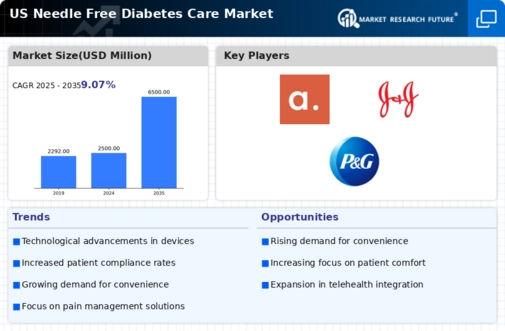Rising Prevalence of Diabetes
The increasing prevalence of diabetes in the United States is a primary driver for the needle free-diabetes-care market. According to the Centers for Disease Control and Prevention (CDC), approximately 34.2 million Americans, or 10.5% of the population, have diabetes. This growing demographic creates a substantial demand for innovative diabetes management solutions, including needle-free options. As patients seek less invasive methods for monitoring and managing their condition, the needle free-diabetes-care market is poised for growth. The convenience and reduced pain associated with needle-free devices appeal to both patients and healthcare providers. This appeal could potentially lead to higher adoption rates. Furthermore, the rising healthcare costs associated with diabetes management may encourage patients to explore more efficient and user-friendly alternatives, thereby driving the market forward.
Supportive Regulatory Environment
A supportive regulatory environment is fostering growth in the needle free-diabetes-care market. Regulatory bodies in the United States, such as the Food and Drug Administration (FDA), are increasingly recognizing the need for innovative diabetes management solutions. The expedited approval processes for new medical devices, particularly those that demonstrate safety and efficacy, are encouraging manufacturers to invest in needle-free technologies. This regulatory support not only facilitates faster market entry for new products but also instills confidence among consumers and healthcare providers. As more needle-free devices receive regulatory approval, the market is likely to expand, offering patients a wider array of options for managing their diabetes effectively.
Increased Focus on Preventive Healthcare
The needle-free diabetes care market is benefiting from a broader trend towards preventive healthcare in the United States. As healthcare providers and patients alike recognize the importance of early intervention in managing diabetes, there is a growing interest in tools that facilitate proactive health management. Needle-free devices, which often allow for easier and more frequent monitoring, align well with this preventive approach. The emphasis on reducing complications associated with diabetes, such as cardiovascular diseases and neuropathy, is driving demand for innovative solutions that promote regular health assessments. Furthermore, public health initiatives aimed at educating individuals about diabetes prevention are likely to enhance awareness and acceptance of needle-free options, thereby contributing to market growth.
Growing Demand for Patient-Centric Solutions
The needle free-diabetes-care market is experiencing a shift towards patient-centric solutions, driven by the increasing emphasis on personalized healthcare. Patients are increasingly seeking products that cater to their individual needs, preferences, and lifestyles. This trend is prompting manufacturers to develop needle-free devices that are not only effective but also user-friendly and aesthetically pleasing. The rise of telehealth and remote monitoring solutions further supports this demand, as patients prefer to manage their diabetes from the comfort of their homes. According to a recent survey, nearly 70% of patients expressed a preference for non-invasive methods of glucose monitoring. This growing inclination towards patient-centric care is likely to propel the needle free-diabetes-care market, as companies strive to meet the evolving expectations of consumers.
Technological Innovations in Diabetes Management
Technological advancements play a crucial role in shaping the needle free-diabetes-care market. Innovations such as continuous glucose monitoring (CGM) systems and smart insulin delivery devices are revolutionizing diabetes management. These technologies not only enhance patient experience but also improve health outcomes by providing real-time data and reducing the need for traditional needle-based methods. The market is witnessing a surge in research and development efforts aimed at creating more effective and user-friendly needle-free devices. For instance, the introduction of microneedle patches and jet injectors has the potential to transform how insulin is administered. As these technologies become more prevalent, they are likely to attract investment and drive market growth, reflecting a shift towards more advanced and less invasive diabetes care solutions.














Leave a Comment